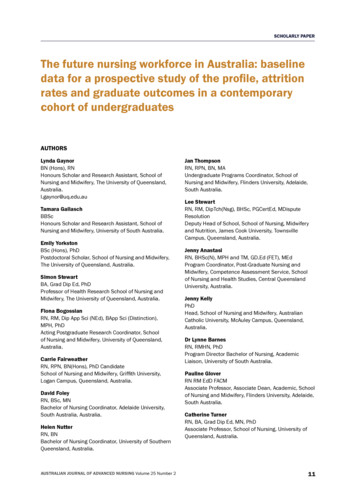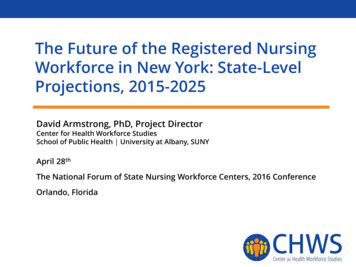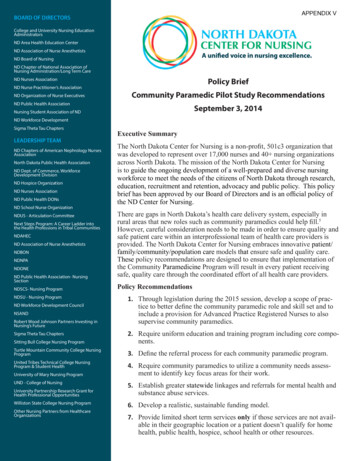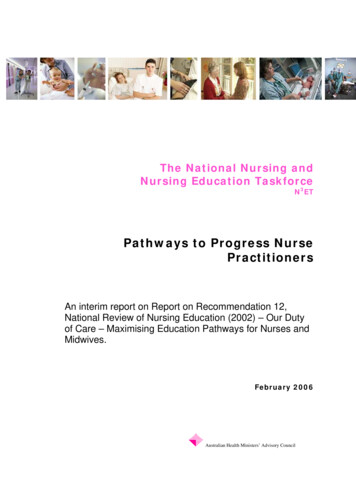
Transcription
SCHOLARLY PAPERThe future nursing workforce in Australia: baselinedata for a prospective study of the profile, attritionrates and graduate outcomes in a contemporarycohort of undergraduatesAUTHORSLynda GaynorBN (Hons), RNHonours Scholar and Research Assistant, School ofNursing and Midwifery, The University of Queensland,Australia.l.gaynor@uq.edu.auTamara GallaschBBScHonours Scholar and Research Assistant, School ofNursing and Midwifery, University of South Australia.Emily YorkstonBSc (Hons), PhDPostdoctoral Scholar, School of Nursing and Midwifery,The University of Queensland, Australia.Simon StewartBA, Grad Dip Ed, PhDProfessor of Health Research School of Nursing andMidwifery, The University of Queensland, Australia.Fiona BogossianRN, RM, Dip App Sci (NEd), BApp Sci (Distinction),MPH, PhDActing Postgraduate Research Coordinator, Schoolof Nursing and Midwifery, University of Queensland,Australia.Carrie FairweatherRN, RPN, BN(Hons), PhD CandidateSchool of Nursing and Midwifery, Griffith University,Logan Campus, Queensland, Australia.David FoleyRN, BSc, MNBachelor of Nursing Coordinator, Adelaide University,South Australia, Australia.Helen NutterRN, BNBachelor of Nursing Coordinator, University of SouthernQueensland, Australia.AUSTRALIAN JOURNAL OF ADVANCED NURSING Volume 25 Number 2Jan ThompsonRN, RPN, BN, MAUndergraduate Programs Coordinator, School ofNursing and Midwifery, Flinders University, Adelaide,South Australia.Lee StewartRN, RM, DipTch(Nsg), BHSc, PGCertEd, MDisputeResolutionDeputy Head of School, School of Nursing, Midwiferyand Nutrition, James Cook University, TownsvilleCampus, Queensland, Australia.Jenny AnastasiRN, BHSc(N), MPH and TM, GD.Ed (FET), MEdProgram Coordinator, Post‑Graduate Nursing andMidwifery, Competence Assessment Service, Schoolof Nursing and Health Studies, Central QueenslandUniversity, Australia.Jenny KellyPhDHead, School of Nursing and Midwifery, AustralianCatholic University, McAuley Campus, Queensland,Australia.Dr Lynne BarnesRN, RMHN, PhDProgram Director Bachelor of Nursing, AcademicLiaison, University of South Australia.Pauline GloverRN RM EdD FACMAssociate Professor, Associate Dean, Academic, Schoolof Nursing and Midwifery, Flinders University, Adelaide,South Australia.Catherine TurnerRN, BA, Grad Dip Ed, MN, PhDAssociate Professor, School of Nursing, University ofQueensland, Australia.11
SCHOLARLY PAPERAcknowledgementsABSTRACTThe research on which this paper is based wasconducted as part of the Nurses and Midwivese‑cohort study (http://www.e‑cohort.net), TheUniversity of Queensland. Funding support from theAustralian Research Council, the National Healthand Medical Research Council, Queensland Healthand the Department of Health, South Australia isacknowledged.ObjectiveTo gather data from ten universities across twoAustralian states in order to: provide a descriptivedemographic profile of undergraduate Australiannursing students; provide baseline data for aprospective analysis of attrition within undergraduatenursing programs; and to facilitate student recruitmentinto a prospective cohort study to examine graduateoutcomes.Key Wordsattrition, retention, undergraduate, nursing,evidence‑based, demographic profileMethodsApproval was sought from each Head of School toenable recruitment of undergraduate nursing studentsas a sub‑sample of an ongoing large scale longitudinale‑cohort study involving Australian, New Zealand andUnited Kingdom nurses and midwives(http://www.e‑cohort.net). Each nursing schoolnominated a contact person to become part ofthe research team; provide aggregate data on thequantity and demographic profile of currently enrolledundergraduate nursing students; and to facilitaterecruitment of students into the cohort study.ResultsTwo of the ten universities could not supply anydemographics of their undergraduate nursing studentbody and one university could not provide data on yearlevels. The remaining data revealed an interestingdemographic profile in the following areas: the agerange of students across both states was 17 to 68years, with just under half the population of studentsaged over 25 years. Some universities had a youngercohort of students in comparison to others and thiswas potentially associated with universities whichonly offered their program in full‑time mode. Thehigh proportion of students choosing to enrol in theirundergraduate program part‑time in South Australia(22.5%) as well as the large number of internationalstudents at one Queensland university (28% in yearone) may impact on the future graduate nursingworkforce supply. Retrospective analysis of the averageattrition rate in Queensland universities was estimatedat 24.5% which is consistent with the findings of arecent systematic review of published primary studies.ConclusionWhilst this preliminary data reveals some interestingissues, in general, there is a paucity of evidence aboutthe demographics of the future Australian nursingworkforce, attrition within undergraduate nursingprograms and graduate outcomes. Clearly there isa need to systematically track undergraduates andnew graduates to quantify student attrition, graduateretention and career plans and begin to build thisevidence‑base. A minimum demographic dataset of allundergraduate nursing students in Australia should beestablished to track trends over time that will informfuture workforce planning.AUSTRALIAN JOURNAL OF ADVANCED NURSING Volume 25 Number 212
SCHOLARLY PAPERINTRODUCTIONThe world has entered a period of scarcity for humanresources in health which in turn impacts on thehealth of populations (Anand and Barnighausen2004). The shortage of qualified health professionals,including nurses, is now one of the largest barriersto achieving the Millennium Development Goals forimproving the health and well being of the globalpopulation (Anand and Barnighausen 2004). Inresponse to this shortage, the International Council ofNurses (ICN) launched the Global Workforce Projectin 2004, and in 2006, the World Health Organisation(WHO) announced the decade of the Health CareWorkforce 2006‑2015 (WHO 2006; ICN 2004).Nurses are the ‘front line’ staff in most globalhealth systems. A nursing shortage undermines theeffectiveness of any health care system, particularlyin small rural and remote communities where a nursemay be the only health practitioner (WHO 2006; ICN2004). Predicted shortages of qualified nurses arereported in Australia, New Zealand, United Kingdom,United States of America and Canada (RCN 2005;Crow and Hartman 2005; ICN 2004; CNA 2002;Crowley and West 2002; DEST 2002).Nurses comprise 40%‑50% of the global health careworkforce and represent 55% of the Australian healthcare workforce (Productivity Commission 2006;WHO 2006). As nurses occupy the largest share ofthe health workforce, a viable health care systemproviding optimum population health outcomes relieson a sustainable and healthy nursing profession(WHO 2006; AIHW 2004). While it is important tounderstand the demographics of the current nursingworkforce in Australia to plan retention strategies andpredict retirement trends for workforce planning, itis also critical to recruit and retain a viable futurenursing workforce. Undergraduate nursing studentscomprise the future nursing workforce and yet thereis currently no demographic data gathered to profilethis group for workforce planning or to quantifyprojected graduate figures.There is an estimated deficit of 40,000 nursespredicted in Australia by the year 2010 (AHWAC 2004;AUSTRALIAN JOURNAL OF ADVANCED NURSING Volume 25 Number 2DEST 2002). Projected estimates to meet workforcedemands report the need for 10 000 graduates peryear from 2006 onward (AHWAC 2004). The latestfigures from the Australian Government Departmentof Education, Science and Training (DEST) show thatonly 5306 domestic nursing students, who form themajority of the future supply stock, completed theirundergraduate program in 2003 (DEST 2004a).TheAustralian Health Workforce Advisory Committee(AWHAC), a national government body to overseehealth workforce planning in Australia, anticipates ashortfall of 4,000 graduates per year, which is 40%above projected graduate completions. Althoughthere are attempts to increase graduate suppliesby increasing university places over the next fouryears, there will still be a significant shortfall in thenursing supply. Additionally, projected workforcesupply estimates are calculated using stablecommencement rates for undergraduate studentnurses and therefore do not include the number ofnon‑completers of pre‑registration nursing courses,as well as assuming a 95% retention rate of newgraduates (AWHAC 2004).There is a paucity of state or national data inAustralia that quantifies attrition in undergraduatenursing programs for workforce supply estimates.National statistics are reported on all studentcommencements and completions in undergraduateprograms but these figures are not reported byspecific field of study (DEST 2004b). The NationalNursing and Nursing Education Taskforce (N3ET),was a government body formed in Australia in 2003to implement recommendations from the NationalReview of Nursing Education (DOHA 2002). The N3ETreference a report from the Australian Council forEducational Research (ACER) which quotes studentattrition rates in nursing programs in Australia at7% (N3ET 2005; McMillan 2005).The ACER report isbased on a sample of young people in Year 9 in 1995and follows the cohort for three years after leavingschool (McMillan 2005). The report however doesnot state a 7% attrition rate in nursing programs; itreports a 9% attrition rate within health as a fieldof education (excluding medicine, dentistry andveterinary science) and there is no data to determine13
SCHOLARLY PAPERif any of the cohort followed were enrolled in nursingprograms (McMillan 2005). Thus the N3ET dataabout undergraduate nurse attrition rates may notbe accurate.Despite decades of debate within the nursingprofession about undergraduate attrition andgraduate retention, a recent global systematicreview found only four studies that examinedundergraduate attrition as an outcome, and nostudies were found that examined retention of newgraduates as an outcome measure (Gaynor et al2006). Only two of the four studies followed cohortsof students prospectively and were able to providea high level of evidence. These studies reported arange of 25‑27% attrition within the first year. Theonly prospective Australian study, based on fouruniversities, measured attrition of undergraduatefirst year nursing students at 27%, and was publishedover ten years ago (Harvey and McMurray 1994). It isimportant to quantify contemporary undergraduateattrition rates for workforce planning and projecteduniversity enrolments.The highest level of evidence for quantifying attritionin undergraduate nursing programs would be yieldedby a prospective cohort study that examines a largecohort of students (or all students) from a range ofprograms and measured individual attrition overtime. This type of study would also enable analysisof factors associated with attrition. The next bestlevel of evidence would be to prospectively gatheraggregate data and quantify attrition over time.The aim of this paper was to do the latter and gatherdata from ten universities across two Australianstates from which it would be possible to: providea descriptive demographic profile of undergraduateAustralian nursing students; provide baseline datafor a prospective aggregate analysis of attrition withinundergraduate nursing programs; and to facilitateindividual student recruitment into a prospectivecohort study to examine graduate outcomes.METHODSApproval was sought from each Head of Schoolin Queensland (n 7) and South Australia (n 3) toAUSTRALIAN JOURNAL OF ADVANCED NURSING Volume 25 Number 2enable recruitment of undergraduate nursingstudents as a sub‑sample of the Nurses and Midwivese‑cohort study (http://www.e‑cohort.net), an ongoinglarge scale longitudinal cohort study involving nursesand midwives from Australian, New Zealand and theUnited Kingdom. This recruitment phase will continueinto first semester 2007 with a view to reporting ongraduate outcomes beyond this time.Each Head of School nominated a contact personto become a part of the research team for theundergraduate demographic and attrition project.Each contact was requested to provide aggregatedata on the quantity and demographic profile ofcurrently enrolled undergraduate nursing studentsand to facilitate recruitment of students into thecohort study. The Behavioural and Social EthicalReview Committee of The University of Queenslandgranted ethical clearance for the study.Each university contact was made an associateinvestigator of the Nurses and Midwives e‑cohortstudy (http://www.e‑cohort.net) and invited tobecome co‑authors of papers reporting the resultsof the aggregate data that each would contribute.One university contact declined co‑authorship. Eachuniversity contact was requested to provide aggregatedata quantifying all undergraduate nursing studentsenrolled at their university after census date in firstsemester, 31 March 2006. Census date is the cutoff date where withdrawal from an undergraduateprogram will not attract academic or financial penalty.It should be noted that some universities have earliercensus dates, however this is the final date at anational level. To prospectively gather data over timeon attrition within programs, the exact number offirst, second and third year students was requestedfrom participating universities. Current DEST datareports a much higher attrition within the first yearof university programs compared to subsequentyears (DEST 2004b). It is important to know thedistribution of undergraduate attrition by year levelacross the three years of the program. Additionaldemographic data collected included: age rangeand mean and proportion of students less than 25years; proportion of enrolled nurses; proportion of14
SCHOLARLY PAPERmales; proportion of part‑time enrolments whereapplicable; proportion of Indigenous students andproportion of international students. Tables 1‑3outline the demographic aggregate data requestedper total student cohort and for each year level;reported per state and reported aggregates acrossboth states of Australia.registration submitted by each Queensland universityin December 2005. These figures were matchedto Queensland Tertiary Admissions data (QTAC) ofaggregate enrolments for undergraduate nursingstudents three years prior, based on census figuresreported from 31st March 2003. Table 4 shows theestimate of attrition within each program and thestate average based on these figures. This couldnot be replicated in South Australia as the samedata could not be accessed from the South AustraliaTertiary Admissions Centre (SATAC).In addition, the in‑kind support of the QueenslandNursing Council was obtained to quantify theaggregate number of eligible graduands for nursingFigure 1. Comparison of Queensland and South Australia universities Demographic Profiles.Demographic VariablesInternationalIndigenousSouth AustraliaPart-timeQueenslandMaleEnrolledAge( 25)0102030405060% Nursing StudentsRESULTSBaseline Aggregate Student DataA major finding of the study was the difficulty thatsome university contacts experienced in accessingthe data requested from university administrativedatabases. Most of the contacts were programcoordinators and maintained aggregate anddemographic data on their undergraduate cohortat school level. Surprisingly, not all universitieswere able to provide data that either quantified allundergraduate nursing students or 1st, 2nd and3rd year undergraduate nursing students. ThoseAUSTRALIAN JOURNAL OF ADVANCED NURSING Volume 25 Number 2university contacts able to supply baseline data willremain involved in the study over the next few yearsas further aggregate data is gathered in 2007 and2008 and actual attrition figures can be reportedprospectively from 1st to 2nd year and 2nd to 3rdyear. Tables 1 and 2 outline the data able to beprovided as of university census date 31st March2006. At present, figures indicate that n 3,755potential nursing graduates in Queensland overthe next few years and n 3,610 potential nursinggraduates in South Australia. A comparison of thedemographic details between the two states isillustrated in figure 1.15
SCHOLARLY PAPERTable 1: Demographic profile of undergraduate nursing students as at census 31st March 2006 tyCentralQueenslandUniversityUniversityof tudentsTotalRangeMean 25 yearsn%n%n%n%n%1st17818‑6025.8n 107, 60%**171018101150282nd13119‑5526.9n 74, 56%**141124182231243rd8920‑5727.0n 55, 62%**111210111100Total39818‑6026.4n 236, 3rd**************************n 946, talThe Universityof iversityJames CookUniversityQueenslandUniversity ofTechnologyEnrolledNursesAgeEnter2nd Year****1st16417‑5021.7n 127, 77%1381382nd10518‑5322.6n 81, 77%77773rd7819‑5026.8n 51, 65%324156Total34717‑5323.2n 259, 5.627.526.9n 148, 60%n 122, 54%n 184, .92.8******Total72217‑5826.6n 454, 63%**9613.38311.5152**17‑6026.6n 1895, ll‑timeenrolmentonly* unable to supply dataDemographic Profile of undergraduate Australiannursing studentsA significant finding from this data is the agedemographics of the student population. The agerange from the combined data sets (table 3) is 17‑68years of age, with just over half of this population(51%) under 25 years of age. Each university hadstudents enrolled who were aged 50 years and someobviously had students aged 60 years or greater,the latter able to make a minimal contribution inemployment years, to the workforce on graduation.The age profile of these students has implicationsfor future workforce planning strategies, consideringthat over 42% of the current workforce are aged 45years or older and will therefore be retiring over thenext 10 to 15 years (AIHW 2004).AUSTRALIAN JOURNAL OF ADVANCED NURSING Volume 25 Number 2Another interesting finding related to agedemographics is the relationship between theyounger ages of the cohort of students at universitiesthat only offer courses as a full‑time option. BothThe University of Queensland and the University ofAdelaide have well over half the student populationunder the age of 25 years (75% and 84%,respectively). Perhaps this reflects the likelihood ofa younger aged cohort to enrol full‑time and furtherinvestigation of these findings, while beyond thescope of this paper, may be significant with respectto workforce planning.Within the South Australian population of students,it is interesting to note a much higher proportion ofstudents who choose to study part‑time, comparedto their Queensland counterparts (22.5% and 9%16
SCHOLARLY PAPERrespectively, see figure 1). This may also impact onfuture workforce patterns, as almost one quarter ofSouth Australian students have chosen this mode ofstudy, and may also choose to work part‑time afterthey graduate. The increase in part‑time work status(and therefore decrease in average weekly hoursworked) is significant when taken into considerationwith population growth. The AIHW (2004) report thatthe nursing supply has decreased from 1,127 FTE(full time equivalent) nurses per 100,000 in 1995to 1024 in 2001, due to the change from full‑timeto part‑time work status.Large numbers of international students in theundergraduate cohort (28% of year one level studentsat ACU, refer table 1) may also be significant withrespect to future graduate supply, if these studentschoose to leave Australia once they have completedtheir degree. The other universities show lowinternational student figures, with South Australiahaving an aggregate total of 7.3% and Queensland9%, although three Queensland universities did notsupply this data and are not reflected in the statetotal.Table 2: Demographic profile of undergraduate nursing students as at census 31st March 2006 South verlandUniversityof AdelaideUniversityof SouthAustraliaCity eveltotalRangeMean 25 years1st36717‑5625.0n 237, 6120‑5618‑6117‑5028.0n 182, 55%n 139, 58%n 558, 60%n 14, 56%n 9, 36%n 3, 19%n 26, 39%n 42, 84%7927166****017‑5022.2n 42, 84%01st77317‑6223.0n 409, 23.026.025.030.035.029.030.0n 356, 52%n 290, 46%n 1055, 51%n 70, 41%n 71, 39%n 46, 41%n 187, 40%17‑6827.1n 1868, .21664.642011.681222.5100.52657.3First year only in 2006Full timeenrolmentonly0* unable to supply dataTable 3: Aggregate demographic profile of undergraduate nursing students as at census 31st March 2006Queensland and South AustraliaAggregateTotalAgeRange Mean736517‑6826.9 25 yearsEnrolledNursesn%n 3763, 51%3214.8AUSTRALIAN JOURNAL OF ADVANCED NURSING Volume 25 Number ous Internationalstudentsstudentsn%n%741534817
SCHOLARLY PAPERRetrospective data on enrolments and attrition inanalysis to gain a more accurate attrition figure, ifQueensland 2003 ‑2005possible.Table 4 outlines the aggregate enrolments inundergraduate university programs for Queenslanduniversities as of census date in 2003: thecorresponding aggregate graduates presented byeach university to the Queensland Nursing Councilin December 2005 and estimated program attritionover the three years.There is a wide range in attrition rates between theuniversities: 9.7%‑41.8%, however it needs to beacknowledged that these figures may not reflect a truepicture of current attrition rates. For example, thesefigures do not take into consideration movement ofstudents between universities and courses, and itwould be prudent therefore to account for transferstudents or entries from other courses in futureTransfer students might partly explain the highattrition rates attributed to the regional universities asco‑authors anecdotally report students often transferfrom regional to metropolitan universities after theirfirst year. In addition, some universities might havea high attrition in the first year but supplement thiswith second year entry level students from eitherenrolled nursing programs, transfer students fromother undergraduate programs or a graduate entrylevel option.The state average aggregate total of 24.5% isconsistent with previous Australian attrition figuresfound in a recent systematic review conducted thatexamined studies using attrition rates as an outcomemeasure (Gaynor et al 2006).Table 4: Retrospective estimate of attrition in undergraduate pre‑registration nursing programs from Queenslanduniversities January 2003 ‑ December 2005Aggregate first yearenrolments March 20031Aggregate graduatesDecember 20052Estimated Attritionover 3 year programAustralian Catholic University726115.30%Central Queensland University22012841.80%UniversityGriffith University3403079.70%James Cook University19813830.30%Queensland University of Technology31024820.00%University of QueenslandUniversity of Southern QueenslandTotalN/A program commenced in 200424116133.20%1381104324.50%1Based on census 31.03.03 QTAC statistical reports of university enrolments2Based on eligible graduand lists provided by each university to QNCDISCUSSIONMaintaining an adequate supply of nurses within theworkforce is partly a function of the number of nursingstudents completing undergraduate programs (Ogleet al 2001). It is therefore vital that key stakeholdersare aware of the demographic profile of contemporarynursing student populations and can quantify attritionrates of programs in order to take these issues intoconsideration for workforce planning.Quantifying and building a demographic database ofthe future nursing workforce provides an evidenceAUSTRALIAN JOURNAL OF ADVANCED NURSING Volume 25 Number 2base for estimating attrition and graduate retentionand systematically tracking trends in changingdemographics and career plans that impact onworkforce planning.There is a lack of data gathered routinely bystate regulatory authorities and national nursingorganisations to determine actual figures for attritionin undergraduate programs and graduate outcomes.Attrition should be considered as an importantoutcome of program evaluation by both universitiesand regulatory authorities accrediting and monitoring18
SCHOLARLY PAPERprograms. Apart from educational evaluationpurposes, it is essential for workforce planning. TheCouncil of Deans of Medicine in Australia (CDAMS)have recognised this need and have established inrecent years a Medical Outcomes project (CDAMS2006). The project aims to establish a nationalminimum dataset of all newly enrolled first yearmedical graduates in Australian universities to assessdemographic trends over time and career choices toinform workforce planning, particularly in specialtyareas. The nursing profession as a matter of urgencyshould establish a similar approach. Nursing needsto monitor trends over time, changes, assess attritionand provide data to inform appropriate numbers ofundergraduate funded places.While attrition rates for undergraduate nursingprograms may be calculated and used internallywithin individual universities, this data is not alwaysmade publicly available. For the purpose of this study,the reasons for gathering minimum datasets on firstyear nursing students is the same as the underlyingprinciples of the CDAMS project ‑ to begin to developan evidence‑base that will enable key stakeholdersto design appropriate workforce planning measuresto meet future nursing workforce requirements.The authors acknowledge that there are limitationsof data matching the QTAC and QNC data as thisdoes not account for movements in and out ofpre‑registration programs during the three years.This data is not detailed enough to account forpart‑time enrolments, graduate entry, enrolled nurseswho might commence in second year, internationaloverseas nurses fast‑tracking, transfers betweenuniversities, and dual degree enrolments. All thesepossibilities of different types of students enrolledthat may complete the program in less or morethan three years are included in both the aggregateenrolment and graduand figures. Whilst the figuresare not perfect estimates they provide some insightinto aggregate state‑based numbers going in toQueensland pre‑registration courses in one year andgraduating three years later.The university data presented in this paper iscross‑sectional and will form baseline data for aAUSTRALIAN JOURNAL OF ADVANCED NURSING Volume 25 Number 2subsequent prospective analysis of attrition acrossyear levels within undergraduate programs over thenext few years.CONCLUSIONThere is a paucity of collated and publishedevidence that captures a demographic pictureof our future nursing workforce; attrition withinundergraduate nursing programs; and graduateoutcomes. Understanding the factors that impacton this population is central to ensuring appropriateworkforce planning strategies. Systematicallytracking undergraduate and newly graduated nursesby establishing a minimum demographic dataseton all Australian undergraduate nursing studentswill facilitate the development of an evidence‑baseto inform appropriate future workforce planningpolicies.REFERENCESAnand, S. and Barnighausen, T. 2004. Human resources andhealth outcomes: cross‑country econometric study. Lancet,364(9445):1603‑9.Australian Health Workforce Advisory Committee (AHWAC). 2004.The Australian nursing workforce ‑ an overview of workforceplanning 2001‑2004, Sydney. AHWAC Report 204.2Australian Institute of Health and Welfare (AIHW). 2004. Australia’sHealth 2004. e/10014 (accessed September 2006).Canadian Nurses Association (CNA). 2002. Planning for the future:nursing human resources projections. http://www.cna‑nurses.ca(accessed September 2006).Council of Deans of Australian Medical Schools (CDAMS).2006. Medical schools outcomes database c1 (accessedSeptember 2006).Crow, S. and Hartman, S. 2005. Attrition in nursing‑ perspectivesfrom the national survey of college graduates. The Health CareManager, 24(4):336‑346.Crowley, R. and West, S. 2002. The patient profession: time foraction. Report on the inquiry into nursing. Senate CommunityAffairs Committee. Canberra, Australia.Australia. Department of Employment, Science and Training.2002. The Nursing Workforce ‑ 2010. Canberra, DEST. No.6925.HERC02A.Australia. Department of Employment, Science and Training DEST.2004a. Students 2004 (full year): selected higher educationstatistics ‑ nursing Students. http://www.dest.gov.au/sectors/higher education/publications resources/profiles/students2004 selected higher education statistics.htm (accessedSeptember 2006).Australia. Department of Employment, Science and TrainingDEST. 2004b. Higher education attrition rates 1994‑2002: a brief19
SCHOLARLY PAPERoverview. http://www.dest.gov.au/sectors/higher education/publications resources/profiles/higher education attritionrates 1994 2002.htm (
School of Nursing and Midwifery, Griffith University, Logan Campus, Queensland, Australia. . McAuley Campus, Queensland, Australia. Dr Lynne Barnes RN, RMHN, PhD . South Australia. Catherine Turner RN, BA, Grad Dip Ed, MN, PhD Associate Professor, School of Nursing, University of Queensland, Australia. AUSTRALIAN JOURNAL OF ADVANCED NURSING .











